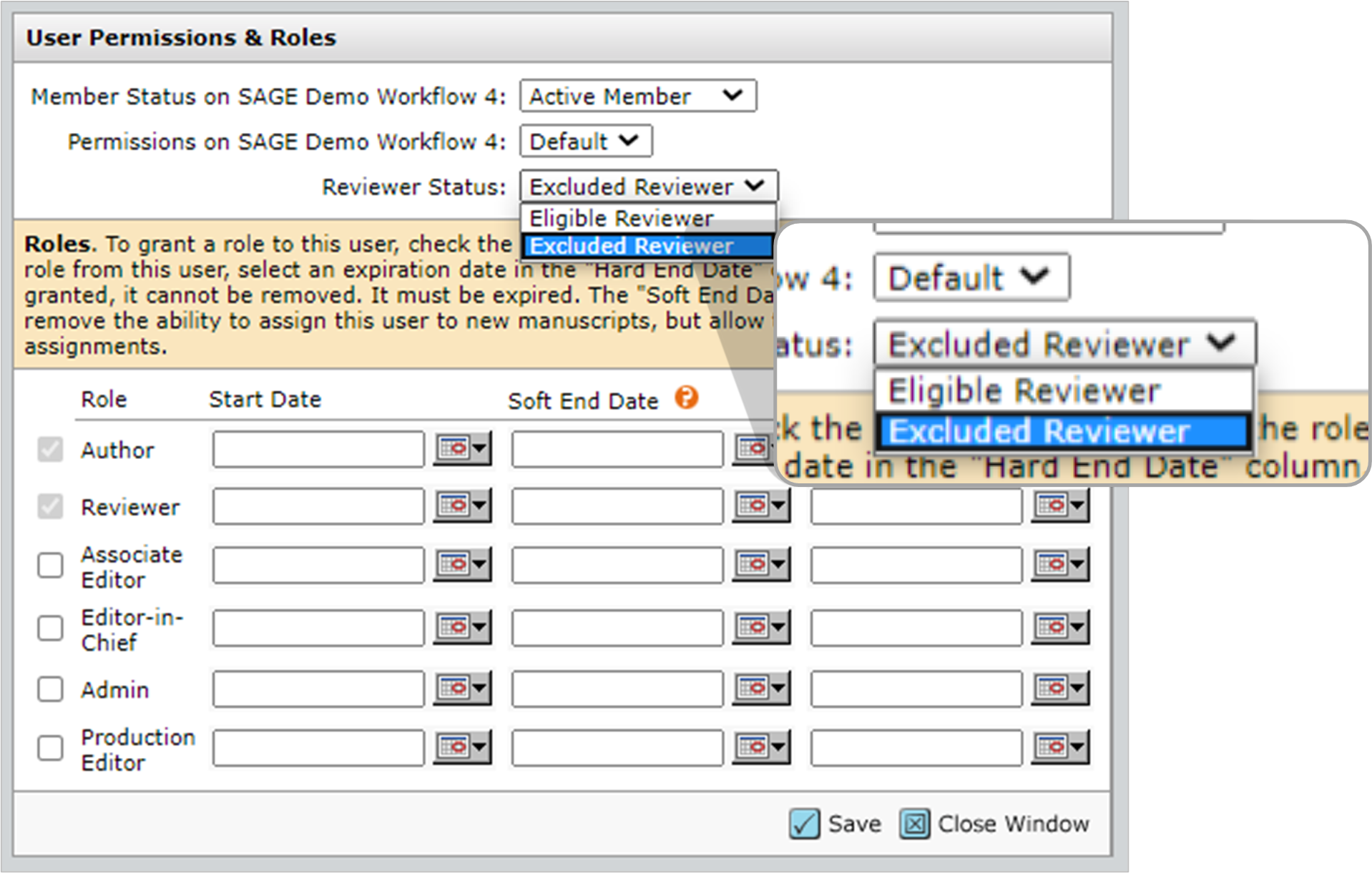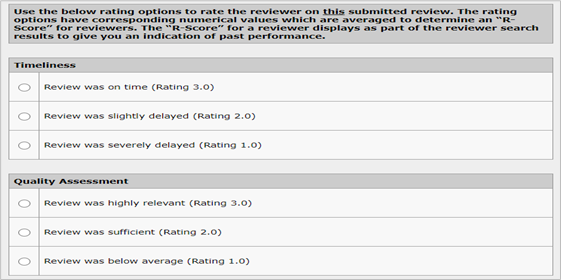You are in: Europe
Change location
You are here
Selecting and Inviting Reviewers
Sourcing reviewers can be the most time-consuming part of an editor’s role. The following guidance aims to minimise the number of invites an editor must send for each manuscript and improve time to decision for our authors.
Click the link to navigate to information on:
- Sage’s peer review policy
- Building an effective reviewer database
- Identifying keywords
- Identifying suitable reviewers
- Ethics and best practice
- Optimising turnaround times
- See also
Sage's peer review policy
In general, Sage strongly recommends obtaining two independent external reviews, which have addressed the paper in detail, before making a first decision.
Unless desk rejected, Reject decisions may be based on a thorough single review.
If the two reviews are insubstantial, highly conflicting or raise any cause for concern, a further review should be sought.
Building an effective reviewer database
To maintain an effective Sage Track database of active reviewers we recommend that you:
- Regularly select reviewers from outside of Sage Track and add them to the database
- Flag inactive reviewers
- Give every review an R-Score
Regularly select reviewers from outside of Sage Track and add them to the database
To do this via the system:
- Click ‘External Searches'

- Select the criteria you would like to search for and then select the platform that you wish to search across
- Selecting too many keywords may overwhelm the search and not provide results; it is suggested to start with the most relevant keyword

- You can search across the following platforms:

- Once you have found a potentially suitable reviewer they must be verified

- If they can be verified, you can add them to the database and invite them:
- Enter the salutation, first name, last name and email address

- You can provide more account information if desired
- Select ‘Create and Add’
- The reviewer will automatically appear in the Reviewer List
- Enter the salutation, first name, last name and email address
Flag inactive reviewers
Edit the user’s account to list them as an ‘Excluded Reviewer’ so that their names don’t pull into your results.

Give every review an R-Score
The R-Score is the average score a reviewer receives from editors. At the bottom of a completed review, you will see two brief rating scales – one for timeliness and one for quality assessment, on a scale from 1 to 3. Simply give your score for the review and click ‘Save’.

Each score a reviewer receives is collected and averaged to produce the overall R-Score. The R-Score is attached to a person’s account and can be used in reviewer searches and reports to find and determine the best reviewers in your site.

TIPS
- Change the sort order of your search results to Primary: R-Score descending to obtain the higher rated reviewers first
- You will get the most accurate R-Score results if every editor in the site rates reviewers for every review completed.
Identifying keywords
To begin, identify the keywords of the manuscript. You may use the author-provided keywords or scan the abstract to find keywords that best represent the topic(s).
Common strategies for identifying keywords:
- JOURNAL TITLE: Often, the journal title will contain a keyword that is essential to the manuscript. For example, all manuscripts from a journal that focuses on HIV and AIDS may want to use ‘HIV’ or ‘AIDS’ as keywords
- TITLE/ABSTRACT: Keywords may also be identified in the title of the manuscript and/or the abstract. For example, a specific drug name or a specific medical condition. For example, ‘children’ could be used to refine the search to only include articles about children;
- MeSH terms: A way to refine phrases that include the keyword. This is useful when the terminology of the manuscript is unfamiliar or if the results were too broad.
Identifying suitable reviewers
It is important to include a basic search for some background information on each reviewer you invite. This not only ensures you’re selecting candidates who are more likely respond positively to your invite, but it’s an important due diligence step for minimising conflicts of interest of biases in the peer review process. Complete checks on the following:
- Identifying suitable reviewers
- Reviewer expertise
- Bias and conflicts of interest
- Checking for conflicts of interest
- Sage Track account info
Reviewer expertise
Reviewers should meet as many of the criteria below as possible:
- The reviewer’s field of study and emphasis is confirmed
- Check their publication record
- Check their institutional page for their specialities within a field of study and what they focus on
- The reviewer is familiar with all aspects of the manuscript
- Look for people who have been first or last authors on several papers in the area, not someone who's consistently in the middle in papers with multiple authors (as they might be a technician or someone with only tangential expertise)
- There is overlap between the reviewer’s previous work and the manuscript
- Keywords essential to the manuscript in process should overlap with those found in a reviewer’s profile or previous work
- The reviewer has reviewed other manuscripts on the same topic (when sourced via the Sage Track database or Web of Science Reviewer Recognition).
Bias and conflicts of interest
When inviting reviewers, it’s necessary to ensure that there is no conflict of interest with the authors. For example:
- The reviewer should have no prior knowledge of the submission
- The reviewer should not have recently (COPE recommend 3 years) collaborated with any of the authors
- Editors should also be aware of potential conflicts of interest between authors and reviewers with regard to industry associations (e.g. relating to relationships with pharmaceutical companies).
Checking for conflicts of interest
Use PubMed to check publications between potential reviewer and list of authors adding the potential reviewer to the string with each iteration.
Use the string: [potential reviewer last name, first name initial][AU] AND ([author 1 last name, first name initial][AU] OR author 2 last name, first name initial][AU] OR [etc.][AU]

Make note of PubMed strings on the Notes section of S1 for that manuscript

Selecting reviewers from areas where duplicate names are common for papers that have authors from the same geographical location may be challenging at times, since checking for conflicts using a PubMed string for these can lead to the identification of erroneous conflicts. PubMed often pulls together any authors with the same last name and initial so looking for bona fide conflicts by supplementing this with a Scopus search can be a way to work around this problem.
Sage Track account info
The following information is available on Sage Track. Click the magnifying glass next to the person’s name to open the pop-up window.
Account information
- Are there any comments in the user’s account information to suggest this person should not be invited? E.g. ‘They have retired’.
Author history
- Has the reviewer previously submitted to the journal? If so, has their submission(s) been accepted or rejected?
Reviewer history
- Has the reviewer reviewed for the journal before?
- If yes:
- It can be useful to look at the reviewer’s past reviews to ensure they have submitted good quality comments
- Their basic history will show the reviewer’s recommendation and the final decision
- When did they last review for the journal? We try to avoid overburdening our reviewers and so would advise against inviting a reviewer who has recently provided a review (e.g. in the last 6 weeks)
- Their basic history will also list their turnaround times (you may wish to avoid inviting reviewers who have routinely provided overdue comments)
- If no:
- Has the reviewer authored a paper previously submitted to the journal? These users may be more likely to agree to review for the journal.
- Has the reviewer previously agreed to review papers but failed to submit comments?
- Has the reviewer recently declined to review a paper?
- Has the reviewer failed to respond to invitations in the past?
- Does the reviewer have any pending assignments? As above, to avoid overburdening our reviewers, we try to avoid concurrent assignments.
NOTE All reviewers must be verified. See ‘Reviewer Verification’ in the Ethics and Best Practice section of this handbook.
Ethics and best practice
See best practice guidance for the following:
- Reviewer verification
- Review content
- Reviewing a paper yourself
- Peer reviews by early career researchers
- Recommended reviewers
Reviewer verification
Once you have found potential reviewers using the selection tips provided in this document, you will need to verify them by taking the following steps:
- Search for the reviewer’s email address using a search engine
- This (especially in cases where the email address is derived from an institution) should lead you to the reviewer’s institutional website
- If you find the person but the email address listed on the website differs from that given on Sage Track, contact the reviewer using the email address provided on the website
- Ask if they can confirm whether they are the same person as the individual who has a Sage Track account registered under the other email address
- Some individuals may have ORCID profiles which will provide information on publications, peer review activity, employment history, education and qualification, and other relevant details
- A fake email address is unlikely to be registered anywhere, or to appear in results.
Institutional email addresses
Institutional, agency and other professional email addresses are useful to Editors as they generally enable the quick and reliable verification of reviewers.
- If you can find an institutional or employer webpage containing the person’s name, email address and some indication of their position, qualifications and expertise, the reviewer is considered ‘verifiable’
- If you can find the reviewer’s institutional website but it does not have a page with their professional qualifications and contact details, try searching for the name in the reviewer’s department or faculty listing.
If the reviewer cannot provide an institutional email address, then consider the following guidance on verifying those with non-institutional email addresses before deciding whether to invite the reviewer.
Non-institutional email addresses
We understand that many researchers either do not have a professional account or prefer to use a personal account. We therefore encourage Sage reviewers to use an institutional email address or, if this is not possible or convenient, ask them to provide the following additional information when using a personal email address:
- Where a reviewer prefers to use a personal email address as their primary contact address, ask that they include an institutional or other professional email address as their Secondary Email Address in their author account on the submission system.
- Where a reviewer(s) does not have a verifiable (via institutional profile page) email address, ask that they state this in the Confidential Comments to Editor (or an email to the Editor/Admin if the review has been submitted) and provide any links to their publication record (associated with that email) or other legitimate public profiles which could be used to verify the individual.
- Where the reviewer(s) are unable to provide this supporting information, they should explain their position in the Confidential Comments to Editor (or email) and ensure they have their ORCID profile linked to email address in question.
- Editors are reminded to check that, where provided, this information is in the Confidential Comments to the Editor and not the Comments to Author.
NOTE
- Be particularly wary of using non-institutional email addresses that include numbers or additional letters, e.g. FIRSTNAME.SURNAMEb@address or INITIAL.SURNAME152@address
- Search for the reviewer’s publication history; is this email address used as their corresponding email for their recent publications?
- If not, contact the email address they have published with and use this (if recent) when inviting them to review
- For reference, here is a list of internet country codes and top-level domains and domain extensions: https://en.wikipedia.org/wiki/List_of_Internet_top-level_domains.
- If you cannot verify a reviewer based on the information you have, you may wish to email the reviewer and ask for an institutional, or other verifiable, email address
- If you have exhausted all options and still cannot verify the reviewer then you should not invite them, or discount their review should they have already submitted it.
TIP If you can verify a reviewer, we recommend adding a note to their account, with a link to the relevant webpage(s). This will make identifying suitable reviewers easier in the future.
Review content
- All reviews and comments should be substantiated
- Reviewers should not recommend citations of their own papers without sufficient explanation as to why the work is relevant
- Be aware of any rapid or short reviews that recommend acceptance or minor revision without detail
- You should also look out for duplicate reviews (i.e. similar reviews from two different accounts for the same manuscript)
- If found, flag this with your Publishing Editor
- For detailed information on Sage’s expectations for the content of a review, see the Reviewer Gateway.
Reviewing a paper yourself
- It is not best practice for editors to review manuscripts to which they are assigned in an editorial capacity
- Contact your Publishing Editor should you have an exceptional circumstance whereby you feel that you may need to review a manuscript yourself
- If you do complete a review for a paper you’re assigned to, then best practice is to provide a non-anonymised review, listing your name and role on the journal at the end of the review comments.
Peer reviews by early career researchers
We can accept reviews from students or junior researchers on the following conditions:
- A supervisor/mentor must agree to provide guidance to the mentee and approve the review comments before submission
- The review comments must be submitted by the early career researcher via their own account (NOTE The supervisor can still receive recognition for their contribution via Web of Science Reviewer Recognition)
- As with any review, the Editor should be confident with the level of detail and quality of the review for it to contribute to their final decision
- Where the appropriate wording is in the Reviewer Invitation email*, upon declining an invitation supervisors can recommend a junior colleague through the ‘Suggested Alternates’ function, using the Comments section to note their status as an Early Career Researcher
In all other cases, supervisors must request permission from the Editor.
*Wording for the reviewer invitation email template
Unable to review at this time?
You will be given the opportunity to recommend alternative expert reviewers should you decline this invitation. Where possible, we ask that you provide institutional email addresses when doing so.
Want to involve a junior colleague in the review?
[Journal name] supports peer review mentoring and accepts reviews from students and junior researchers. Should you decline this invitation but wish to suggest a junior colleague to review the paper, type ‘Early Career Researcher’ or ‘ECR’ in the Comments Box when recommending alternative reviewers for the paper. Note that you will be expected to provide guidance and approve the final comments before the review is submitted.
Recommended reviewers
In general, Sage does not permit the use of author-suggested reviewers. If your journal has an agreement with the Publishing Editor which allows recommended reviewer use then it is essential to adhere to the guidance on the Editor Gateway
Optimising turnaround times
Improve time to first and final decision for authors with the following:
Alternate reviewers
- Queue invites for multiple suitable reviewers using the ‘Alternates’ function
- Using the Order column, you can move reviewers into the list as ‘Alternate 1’ (or 2, 3, etc. depending on how many people you find) and click ‘Save’
- If anyone from the main reviewer list declines to review, the system will auto-invite from the alternates list
- This saves time as the next reviewer does not have to be manually invited and the invitation is sent out at the earliest possible time.

Customising invitations
- A positive response may be more likely if you tailor the invitation to the reviewer
- If there is a specific reason why you are inviting them, then include a note on this toward the beginning of the invitation.
Add additional templates
- Reviewer reminders
- Alternative reviewer suggestion for papers with overdue reviewers.
See Also
Reviewer Videos:
COPE Ethical Guidelines for Peer Reviewers: https://publicationethics.org/resources/guidelines-new/cope-ethical-guidelines-peer-reviewers
Responsibilities in the Submission and Peer-Review Process: http://www.icmje.org/recommendations/browse/roles-and-responsibilities/responsibilities-in-the-submission-and-peer-peview-process.html
Peer Review: The Nuts and Bolts: https://senseaboutscience.org/wp-content/uploads/2016/09/peer-review-the-nuts-and-bolts.pdf
How to select peer reviewers: Advice from an expert journal editor: https://www.editage.com/insights/how-to-select-peer-reviewers-advice-from-an-expert-journal-editor